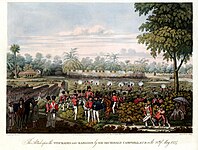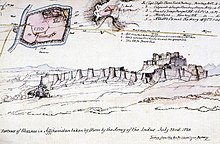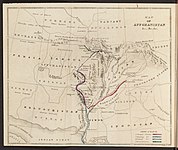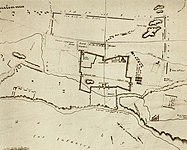User:Ficaia/William Henry Dennie
William Henry Dennie | |
|---|---|
| Born | 22 June 1789 Deptford, Kent |
| Died | 6 April 1842 (aged 52) Jellalabad, Afghanistan |
| Allegiance | |
| Service/ | British Army |
| Years of service | 1804–1842 |
| Rank | Colonel |
| Commands held | 13th Light Infantry |
| Battles/wars | |
Colonel William Henry Dennie, CB, ADC (1789–1842) was an officer in the British Army. He served in India from 1804–1805; was present at the capture of Mauritius in 1810; served in the Channel islands and Ireland, and for his services in Burmah was made brevet lieutenant-colonel and CB. During the First Afghan War, he led the storming party at the capture of Ghuznee in 1839; defeated Dost Mahomed at Bameean in 1840; was made aide-de-camp to Queen Victoria; fought in the defence of Jellalabad, and was slain in a sortie from that city in 1842. He rose to the rank of major in the 22nd Foot, and colonel of the 13th Light Infantry.
Origins[edit]
William Henry Dennie was born at Deptford, Kent, on 22 June 1789,[1] the son of Henry Dennie, barrister-at-law, of London, by his wife, Grace, daughter of William Steele, and granddaughter of Laurence Steele of Rathbride, County Kildare, who married, secondly, Colonel William Kent, some time of the 10th Foot and afterwards of the Isle of Wight,[2] and died in 1856.[3]
Service[edit]
Dennie's father appears to have had a brother (possibly) in the 38th Foot, when that regiment was commanded by Colonel (afterwards General) Edward Fox, and through Fox his widowed mother obtained for him an ensigncy in the 22nd Foot, dated 1 January 1800. He became lieutenant therein in August 1804; captain on 4 October 1810; and major on 19 April 1821. He first joined the regiment after its arrival in India in 1802, and won Lord Lake's approval by his conduct during some regimental disorder.[4] Dennie served with the regiment throughout Lord Lake's campaigns in India in 1804–1805, at the capture of Mauritius (Isle of France) in 1810, and afterwards in Mauritius, the Channel Islands, and Ireland.
After obtaining his majority he exchanged to the 13th Foot, which soon after was made light infantry and ordered to India. With the 13th Foot he served during the First Burmese War, in which he distinguished himself on many occasions, and was severely wounded. For his services in Burmah he was made brevet lieutenant-colonel and CB. He likewise served with the regiment in the so-called 'Grand Army of the Indus' in 1838–1839.
When General Nott was appointed to the second division of the army, Dennie succeeded to the command of his native brigade, and was employed in Scinde, Beloochistan, and Lower Afghanistan, which he considered the most arduous duty on which he was ever employed. His services were unacknowledged at headquarters, where there appears to have been a desire to make him a scapegoat for the administrative blundering incidental to Afghan campaigns. He led the storming party at the capture of the fortress of Ghuznee, where he was the first man within the walls after the blowing open of the gates. Dennie was in disfavour at headquarters at the time, and the Ghuznee honours conferred on some of his juniors in service and inferiors in army rank were withheld from him by an official quibble. Of this he complained respectfully but bitterly to the Indian authorities and the Horse Guards, without redress.
Fierce, fiery, romantically chivalrous, as a writer in the Bombay Gazette described him, Dennie appears to have been irritably impatient of acts of injustice to which he himself would have been no party, but which would scarcely have moved a less sensitive man. During the occupation of Cabul, Dennie was despatched with a small force in September 1840 against part of the army of Dost Mahomed, which, after a series of brilliantly executed manoeuvres amid the fastnesses of the Hindu Khoosh,[5] he brought to battle at Bameean on 18 September 1840, when with one thousand men he defeated ten thousand of the enemy, who lost over eight hundred killed and wounded. So decisive were the results that Dost Mahomed surrendered immediately afterwards, and the campaign came to an end.
In October 1841 a force under Sir Robert Sale was sent from Cabul against a body of Afghan insurgents who had occupied the Khoord Cabul. These troops, of which the 13th Light Infantry formed part, seized the ruined fortress of Jellalabad, and rendered themselves "illustrious" by its subsequent defence from November 1841 to April 1842. Dennie commanded the rear-guard in the operations in the Khoord Cabul between 9 October and 30 October, and, when Sir Robert Sale was wounded, succeeded to the command of the force, which he held during the greater part of the famous defence of Jellalabad. He is said to have predicted the disaster to General Elphinstone's army, and even the receipt of the tidings by a solitary survivor, a prediction strangely fulfilled by the arrival of Dr. Brydone at Jellalabad.[6]
Death[edit]
Dennie was shot through the body when on horseback at the head of his regiment, in the sortie from Jellalabad of 6 April 1842. The wound proved fatal before he got back to the city. He was buried in a bastion used as a graveyard by the garrison, over which the earth was designedly projected when the defences were blown up on the British leaving the place. Dennie's services had been recognised in England by his appointment as aide-de-camp to Queen Victoria, tidings of which (reports to the contrary notwithstanding) reached Jellalabad a week before his fall.[7]
Legacy[edit]
Colonel Dennie fell after forty-two years' military service, all passed on full pay and mostly in India, during which he had purchased every step of regimental rank. According to Henry Manners Chichester, he was "a soldier as brave as any the British army ever produced, and as good an officer as any that served through the war in Afghanistan."
After his death, Dennie's letters from the seat of war in Afghanistan were published in the Dublin University Magazine, and afterwards as a separate volume, entitled Narrative of Campaigns in Scinde, Beloochistan, and Afghanistan (Dublin, 1843). The volume contains Dennie's correspondence with the military authorities, respecting his treatment at Ghuznee, and his reasons for rejecting the offer of an inferior grade of the Dooranee decoration. The medal to which he was entitled for the defence of Jellalabad was forwarded to his aged mother, and to four unmarried sisters chiefly depending on him small pensions were subsequently awarded.
Honours[edit]
Gallery[edit]
-
The Attack upon the Stockades near Rangoon, 28 May 1824 (1825)
-
The Storming of Ghuznee. The Storming Column entering the Fortress, 23 July 1839
-
Plan of Ghuznee by Lt. Thomas Gaisford, Bombay Artillery
-
Map of Afghanistan printed with Dennie's correspondence (1843)
-
Map of Jellalabad in 1842 (c. 1846)
References[edit]
Sources[edit]
- Burke, Bernard (1871). A Genealogical and Heraldic History of the Landed Gentry of Great Britain and Ireland. 5th ed. Vol. 2. London: Harrison. p. 1312. [under "Steele of Rathbride"].
- Carter, Thomas (1867). Historical Record of the Thirteenth, First Somersetshire, or Prince Albert's Regiment of Light Infantry. London: W. O. Mitchell. pp. 77–83, 87, 91, 94–99, 102, 104, 107–118, 131.
- Chichester, H. M.; Lunt, James (2012). "Dennie, William Henry (1789–1842), army officer". Oxford Dictionary of National Biography (online ed.). Oxford University Press. doi:10.1093/ref:odnb/7501. (Subscription or UK public library membership required.)
- The Gentleman's Magazine. New Series, Vol. 1. July–December 1856. London: John Henry and James Parker. p. 122.
Attribution:
 This article incorporates text from a publication now in the public domain: Chichester, Henry Manners (1888). "Dennie, William Henry". In Stephen, Leslie (ed.). Dictionary of National Biography. Vol. 14. London: Smith, Elder & Co. pp. 368–369.
This article incorporates text from a publication now in the public domain: Chichester, Henry Manners (1888). "Dennie, William Henry". In Stephen, Leslie (ed.). Dictionary of National Biography. Vol. 14. London: Smith, Elder & Co. pp. 368–369.
Further reading[edit]
- Kaye, John William (1874). History of the War in Afghanistan. 3rd ed. Vol. 1. London: Wm. H. Allen & Co. pp. 463–465.
- Kaye, John William (1874). History of the War in Afghanistan. 3rd ed. Vol. 2. London: Wm. H. Allen & Co. pp. 72, 84–86, 156, 342, 344, 348–349, 359.
- Kaye, John William (1874). History of the War in Afghanistan. 3rd ed. Vol. 3. London: Wm. H. Allen & Co. pp. 57, 64, 71, 95–97.
- The Gentleman's Magazine. New Series, Vol. 18. July–December 1842. London: William Pickering; John Bowyer Nichols and Son. pp. 95–96.
External links[edit]
- "Dennie, William Henry, 1785?-1842". The Online Books Page. Retrieved 1 November 2022.
- "Personal narrative of the campaigns in Affghanistan, Sinde, Beloochistan, etc." Library of Congress. Retrieved 1 November 2022.





